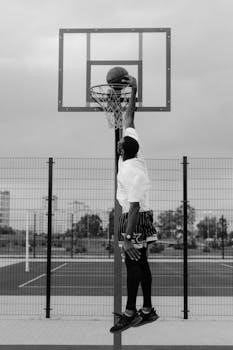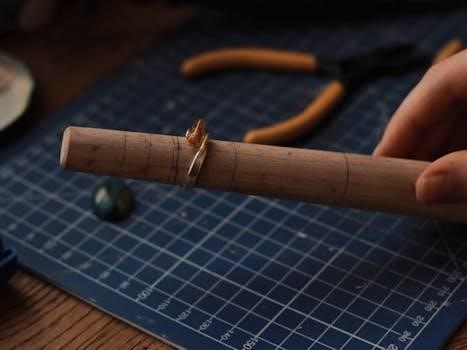Jump rings are critical components of jewelry making․ Understanding jump ring size is essential for successful projects․ This guide covers basics, types, and terminology․ Learn about gauge charts, OD, ID, and the difference between machine cut and saw cut jump rings for crafting․
Understanding Jump Ring Basics
Jump rings serve as fundamental connectors in jewelry design, linking various components seamlessly․ They are essential for attaching clasps, pendants, charms, and other decorative elements to necklaces, bracelets, earrings, and anklets․ Understanding their basic properties is crucial for any jeweler․
Typically measured by their inner diameter (ID), outer diameter (OD), and wire gauge, jump rings come in various sizes and materials, each serving a specific purpose․ The gauge refers to the thickness of the wire used, while the inner diameter is the measurement across the inside of the ring․
Choosing the right jump ring involves considering the weight and size of the elements being connected, as well as the desired aesthetic․ A heavier pendant, for example, requires a thicker gauge jump ring for secure attachment, while delicate chains benefit from finer gauges to maintain a cohesive look․
Whether you opt for pre-made jump rings or prefer crafting your own, a solid grasp of these basics will empower you to create jewelry that is both visually appealing and structurally sound․ Mastering jump ring selection is key to professional looking jewelry․

Jump Ring Terminology⁚ ID, OD, and Gauge
Navigating the world of jump rings requires understanding three key terms⁚ Inner Diameter (ID), Outer Diameter (OD), and Gauge․ These measurements dictate a jump ring’s size and strength, influencing its suitability for various jewelry-making tasks․ Let’s break down each term⁚
Inner Diameter (ID)⁚ The ID is the measurement across the inside of the jump ring, determining the space available for attaching other components․ It’s the most crucial measurement to consider when selecting a jump ring, as it dictates whether the ring will fit through the intended loops or holes․
Outer Diameter (OD)⁚ The OD is the measurement across the entire jump ring, including the wire’s thickness; While less critical than the ID, the OD influences the overall aesthetic and spacing of your design․ Calculating it involves adding twice the wire diameter to the inner diameter․
Gauge⁚ The gauge refers to the thickness of the wire used to make the jump ring․ Lower gauge numbers indicate thicker wire, resulting in stronger and more robust rings․ Higher gauge numbers correspond to thinner wire, suitable for delicate designs․ Choosing the right gauge ensures the jump ring can withstand the stress of wear․
Importance of Inner Diameter (ID)
The Inner Diameter (ID) of a jump ring is arguably the most critical measurement to consider when selecting the right component for your jewelry project․ Its significance stems from its direct influence on the functionality and aesthetic integration of the jump ring within the overall design․
The ID dictates compatibility․ When connecting different jewelry components, the ID must be large enough to accommodate the thickness of the elements being joined․ A too-small ID will render the jump ring unusable, while an excessively large ID can create unsightly gaps and weaken the connection․
Furthermore, the ID affects visual harmony․ The size of the jump ring should complement the scale of the other components․ A disproportionately large or small ID can disrupt the visual balance, detracting from the piece’s overall aesthetic appeal․
Accurate ID measurement is essential for chain maille, where precise ring dimensions are paramount․ Selecting the correct ID ensures the chain maille pattern is properly executed, resulting in a strong and visually appealing piece․
Ultimately, mastering the ID empowers jewelers to create secure, visually pleasing, and professionally finished pieces․
Measuring Jump Rings⁚ Metric vs․ Imperial
When working with jump rings, understanding the difference between metric and imperial measurement systems is crucial․ The metric system, using millimeters (mm), is widely adopted globally and offers a decimal-based approach, simplifying calculations․ Conversely, the imperial system, employing inches, remains prevalent in the United States․
Jump rings are typically measured by their Inner Diameter (ID), Outer Diameter (OD), and wire gauge․ Both metric and imperial units can express these measurements․ For instance, an ID might be specified as 5mm (metric) or approximately 0․197 inches (imperial)․
Conversion between these systems is often necessary․ Jewelers accustomed to one system may encounter components measured in the other․ Online tools and charts facilitate conversion, ensuring accurate matching of jump rings to project requirements․
While wire gauge is technically unitless, it relates to physical dimensions expressed in either system․ Gauge charts provide corresponding metric and imperial values, aiding selection․
Consistency is key․ Within a single project, using one measurement system avoids errors․ If mixing components from different sources, convert all measurements to a common unit before ordering․ This minimizes discrepancies and ensures a seamless integration of jump rings․
Jump Ring Gauge Chart (AWG and SWG)
A jump ring gauge chart is an essential resource for jewelers, providing a standardized reference for wire thickness․ Two common systems are the American Wire Gauge (AWG) and the Standard Wire Gauge (SWG), also known as the British Standard Wire Gauge․
The AWG system is predominantly used in North America, while SWG sees use in Britain and other regions․ Both systems assign numbers to wire diameters; however, the relationship is inverse – a lower gauge number indicates a thicker wire․
A gauge chart lists gauge numbers alongside their corresponding diameters in inches and millimeters․ This allows jewelers to quickly determine the physical thickness of a wire based on its gauge and vice versa․

For example, 18-gauge wire is a popular choice, measuring approximately 1․02mm in diameter according to AWG standards․ The chart clarifies slight differences between AWG and SWG values for the same gauge number․
When selecting jump rings, consult a gauge chart to ensure compatibility with other components and the desired aesthetic․ Using the wrong gauge can result in weak connections or a mismatch in appearance․ These charts facilitate informed decisions, promoting quality craftsmanship․
Common Jump Ring Gauges and Their Uses
Choosing the correct jump ring gauge is crucial for jewelry making, ensuring both aesthetic appeal and structural integrity․ Different gauges serve specific purposes, and understanding these applications is vital for successful designs․ Here’s a look at common gauges and their typical uses․
20 Gauge (0․8mm)⁚ This is a versatile gauge suitable for lightweight earrings and delicate chains․ Its thinner profile makes it ideal for pieces where subtlety is key․
18 Gauge (1․0mm)⁚ A bit thicker, 18-gauge jump rings are excellent for connecting medium-sized components like pendants and clasps․ They offer a good balance of strength and flexibility․
16 Gauge (1․3mm)⁚ This gauge provides added durability, making it suitable for bracelets and heavier necklaces․ It’s often used in pieces that require a more robust connection․
14 Gauge (1․6mm)⁚ Offering significant strength, 14-gauge jump rings are ideal for heavy-duty applications, such as keychains or connecting large, weighty components․
Other Gauges⁚ Finer gauges, like 22 or 24, are used for intricate wirework․ Thicker gauges, such as 12 or 10, are used for very heavy pieces needing exceptional strength․
Consider the weight and size of the components you’re connecting when selecting a gauge․ Choose appropriately to ensure a secure and visually appealing result․
Calculating the Outside Diameter (OD)
Understanding how to calculate the Outside Diameter (OD) of a jump ring is a fundamental skill for jewelry makers․ The OD is the total diameter of the jump ring, encompassing both the inner space and the thickness of the wire used․ Knowing the OD is crucial for accurate design and consistent results․

The formula for calculating OD is straightforward⁚ OD = ID + (2 * Wire Diameter)․ In this equation, ID represents the Inner Diameter, which is the measurement of the open space inside the ring․ The “Wire Diameter” is the thickness of the wire used to create the jump ring․
For example, if you have a jump ring with an Inner Diameter (ID) of 6mm and the wire used is 2mm thick, the calculation would be⁚ OD = 6mm + (2 * 2mm) = 6mm + 4mm = 10mm․ Therefore, the Outside Diameter (OD) of the jump ring is 10mm․
This calculation is essential when planning the overall size and appearance of your jewelry piece․ It ensures that the jump rings fit seamlessly with other components, contributing to a polished and professional finish․ Accurate OD calculation prevents mismatches and ensures design harmony․
Aspect Ratio (AR) Calculation
The Aspect Ratio (AR) is a crucial concept in jewelry making, particularly when working with chainmaille or creating intricate designs with jump rings․ It essentially describes the relationship between the Inner Diameter (ID) of a jump ring and its wire thickness․ Understanding and calculating AR is vital for achieving the desired flexibility, strength, and visual appeal in your projects․
The formula for calculating Aspect Ratio is AR = ID / Wire Diameter․ This simple equation provides a numerical value that represents how many times the wire thickness fits into the inner diameter of the jump ring․ The higher the AR, the more flexible and open the jump ring will be, while a lower AR indicates a tighter, more rigid ring․
For instance, if a jump ring has an Inner Diameter of 5mm and a wire thickness of 1mm, the Aspect Ratio would be AR = 5mm / 1mm = 5․ This means the wire thickness fits into the inner diameter five times․

When calculating the Aspect Ratio, it’s crucial to use consistent units of measurement․ If the Inner Diameter is in millimeters, the wire thickness must also be in millimeters․ Similarly, if using inches, both measurements must be in inches․ This consistency ensures an accurate AR calculation․
Machine Cut vs․ Saw Cut Jump Rings
When selecting jump rings for your jewelry projects, you’ll encounter two primary types⁚ machine cut and saw cut․ The method used to create these rings significantly impacts their appearance, closure, and overall suitability for various applications․ Understanding the differences between machine cut and saw cut jump rings is crucial for making informed choices and achieving professional results․
Machine Cut Jump Rings⁚ These rings are produced using automated machinery that precisely cuts the wire, creating a clean, consistent cut․ Machine cut rings are typically more affordable and readily available than saw cut rings․ However, they often have a slight burr or sharp edge at the cut point, which can prevent a perfectly flush closure․ This gap can be noticeable in delicate designs and may require additional filing or polishing․
Saw Cut Jump Rings⁚ Saw cut jump rings are created using a fine jeweler’s saw, resulting in a very thin, precise cut․ This method produces rings with perfectly flush ends, allowing for seamless closures․ Saw cut rings are ideal for intricate chainmaille projects, delicate beadwork, and any design where a clean, invisible join is essential․ However, saw cut rings are generally more expensive due to the labor-intensive manufacturing process․
Materials and Gauges Available
Jump rings are available in a wide array of materials and gauges, offering versatility for various jewelry styles and functional requirements․ Selecting the appropriate material and gauge is crucial for ensuring the durability, aesthetic appeal, and overall success of your designs․
Materials⁚ Jump rings come in various metals, each with unique properties․ Sterling silver is a popular choice for its lustrous appearance and malleability․ Gold-filled jump rings offer a cost-effective alternative to solid gold, providing a durable layer of gold bonded to a base metal․ Copper and brass jump rings are often used in artistic or rustic designs, offering warm tones and affordability․ Stainless steel and niobium jump rings are hypoallergenic and tarnish-resistant, making them ideal for sensitive skin․ Anodized aluminum jump rings provide a range of vibrant colors and lightweight construction, suitable for playful or contemporary pieces․
Gauges⁚ Jump ring gauge refers to the thickness of the wire․ Common gauges range from 10 to 24, with 18 gauge being a popular choice․ Thicker gauges (e․g․, 10-16) are suitable for heavier pendants and clasps, providing strength and durability․ Thinner gauges (e․g․, 20-24) are ideal for delicate earrings, lightweight chains, and intricate beadwork․ The selection depends on the specific demands of your jewelry design․
Jump Rings for Different Jewelry Types
The selection of jump rings is highly dependent on the specific type of jewelry you’re creating․ Different jewelry types demand varying levels of strength, flexibility, and aesthetic appeal, which, in turn, dictate the most suitable jump ring size, gauge, and material․
Necklaces⁚ For necklaces, consider the weight and style of the pendant or focal bead․ Heavier pendants require sturdier jump rings with a thicker gauge to ensure secure attachment and prevent breakage․ Lightweight chains often benefit from smaller, more delicate jump rings that seamlessly integrate with the overall design․
Bracelets⁚ Bracelets, especially those with multiple strands or charms, require durable jump rings that can withstand constant movement and friction․ Opt for heavier gauges and robust materials like sterling silver or stainless steel to maintain the integrity of the bracelet․
Earrings⁚ Earrings typically utilize finer jump rings, particularly for delicate dangles or lightweight components․ Smaller gauges ensure comfortable wear and prevent the earrings from becoming too heavy․ Consider the overall aesthetic of the earrings when selecting the jump ring material, opting for complementary colors and finishes․
Anklets⁚ Similar to bracelets, anklets require jump rings that can endure regular wear and potential stress․ Sturdier gauges and durable materials are recommended to prevent breakage and ensure the anklet remains intact․
Tips for Choosing the Right Size Jump Ring
Selecting the correct jump ring size is crucial for jewelry making success․ A well-chosen jump ring ensures structural integrity, aesthetic appeal, and ease of use․ Here are some practical tips to guide your selection process⁚
Consider the weight and size of components⁚ Heavier components require thicker gauge jump rings to support the weight and prevent breakage; Larger components may necessitate larger inner diameters to accommodate the attachment․
Match the jump ring material to the jewelry piece⁚ Use similar metals to maintain consistency and prevent galvanic corrosion․ For example, use sterling silver jump rings for sterling silver jewelry․
Think about the desired aesthetic⁚ Smaller, delicate jump rings are suitable for refined, elegant designs, while larger, bolder jump rings can enhance a more rustic or contemporary style․
Consider the opening and closing mechanism⁚ Choose between open and closed jump rings based on the project requirements․ Open jump rings are easier to open and close, while closed jump rings provide greater security․
Don’t underestimate the importance of gauge⁚ The gauge affects the strength and appearance of the jump ring․ Thicker gauges provide greater strength, while thinner gauges are more subtle․
Always test before committing⁚ Before finalizing your selection, test a sample jump ring to ensure it meets your expectations for size, strength, and aesthetic appeal․
Where to Buy Jump Rings
Sourcing high-quality jump rings is crucial for any jewelry maker․ The market offers various options, from online retailers to local craft stores․ Here’s a guide to help you find the best place to purchase jump rings⁚
Online Retailers⁚ Online platforms like Rio Grande, Etsy, and Amazon offer a vast selection of jump rings in various sizes, materials, and gauges․ These retailers often provide competitive prices and convenient shipping options․
Specialty Jewelry Supply Stores⁚ These stores specialize in jewelry-making supplies and offer a curated selection of jump rings․ They often have knowledgeable staff who can provide expert advice․
Local Craft Stores⁚ Local craft stores like Michaels and Hobby Lobby carry a limited selection of jump rings․ These stores are a good option for beginners or those who need a small quantity of jump rings quickly․
Wholesale Suppliers⁚ Wholesale suppliers like The Bead Man cater to jewelry professionals and offer bulk discounts on jump rings․ These suppliers are ideal for those who need a large quantity of jump rings regularly․
Considerations When Choosing a Vendor⁚
- Quality⁚ Look for jump rings made from high-quality materials and with precise dimensions․
- Selection⁚ Choose a vendor that offers a wide variety of sizes, materials, and gauges to meet your specific needs․
- Price⁚ Compare prices from different vendors to find the best deal․
- Shipping⁚ Consider the shipping costs and delivery time when making your decision․